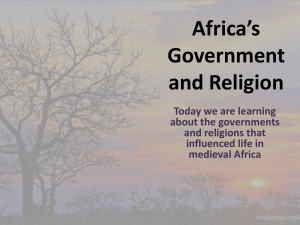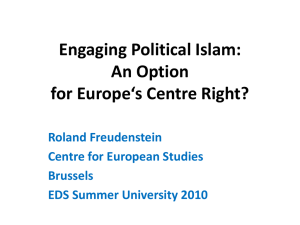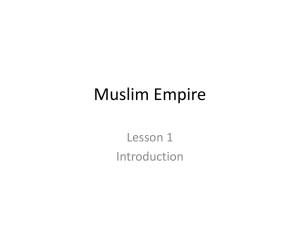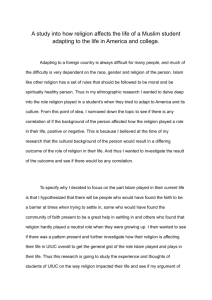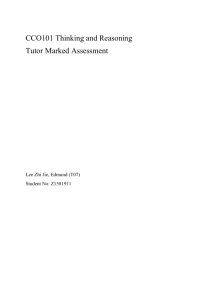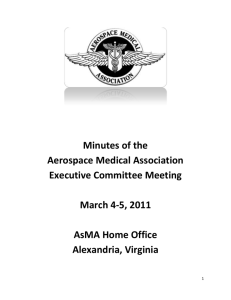Scourfield Edinburgh R+S 2012 2
advertisement
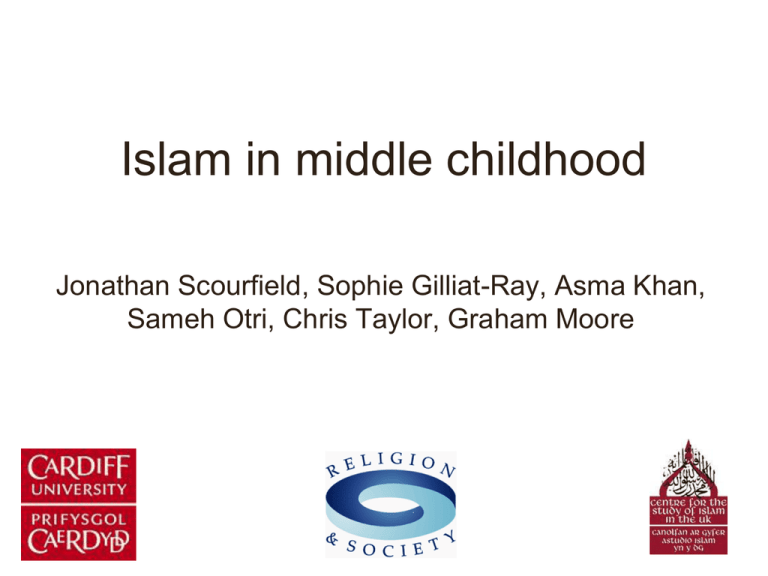
Islam in middle childhood Jonathan Scourfield, Sophie Gilliat-Ray, Asma Khan, Sameh Otri, Chris Taylor, Graham Moore The research project • Religious nurture in Muslim families • Secondary analysis of the Citizenship Survey • Qualitative research - Muslim families with children aged 12 and under Plan of talk • Brief explanation of method • Findings of secondary analysis of Citizenship Survey 2003 • Theories arising from qualitative research to explain why the transmission of Islam is more successful • Digital stories Our sample of families in Cardiff Ethnic origin 20 Pakistani 10 Bangladeshi 5 Indian 5 Somali 9 Middle Eastern 7 Mixed ethnicity 4 Others Social Class (National Statistics Socio-Economic Classification) 15 managerial and professional occupations 24 intermediate occupations 18 Routine and manual occupations 3 unclassified (students and asylum seekers) • 60 Muslim families where there are children of primary school age and below • Interviews with at least two generations (99 parents and 120 children) • Children kept oral diaries and take photographs in 24 families • Some observation of formal learning from Scourfield et al. 2012 Why is the transmission of Islam relatively successful in a secular context? 1. Formal learning and the role of religious institutions 2. The habitus of family and community 3. Minority effects 4. The cognitive science of religion 1. Formal learning and the role of religious institutions • Primarily Arabic language tuition, with some Islamic input (5 families) • Learning to read the Qur’an in Arabic. 51 families (27 home-based classes; 24 mosque-based). In 11 families, classes were taught by a parent. 2 children did all Qur’an learning in a Muslim primary school. • Islamic studies classes, (8 families). 2. The habitus of family and community Interview with Mr Assad I don’t think it was a thing of introducing Islam to him because actually it was just part of our culture, you know, the praying, you know, the getting up for Fajr, you know, the fasting, you know. Even the way we conducted ourselves in trying to bring him up. So I don’t think it was a thing of introducing Islam to him. I think it was something he just came into. Interview with Aamira Miller (age 11) Asma: So you learnt how to pray because you watched your mum and you joined in? Aamira: It’s just weird, it’s just, all of a sudden I just knew. Probably because you know your surahs because you do your Qur’an cos I know a few off by heart, they’re like some of the back ones and they’re not that long and once you know surahs and the main bits like when you go down, when you’re like when you put your hands your knees, stand up, when you’re kind of bending yeah? You just learn because you do it for every single day basically of a year yeah? Well most of the year. And like you’re just never going to forget it. 3. Minority effects Interview with Sahra (10) and Fathia Adam (8) Asma: Ok so you don’t think that it’s good to force people to be Muslim, you think that we should choose? Sahra: I think its good for, I think if somebody wants to force them I don’t think they should force them I think they should teach them into Islam and then, and then they get a choice, so. Fathia: But we’re already Muslims. Interview with Daniyaal (10) and Ehlenoor (8) Faysal Daniyaal: Expelled for wearing the scarf? Whoever does that must be insane! Asma: Why do you think it would be insane to expel somebody who wore a scarf? Daniyaal: I mean it’s just a religious sort of thing, it’s not like it’s going to kill the world is it? It’s not going to destroy the school’s reputation, it’s just a girl wearing a scarf, she’s doing what her religion wants her to do. Asma: And that’s ok? Daniyaal: If they just expelled them just for wearing that I’d be going crazy, I’d be like what the fffff, what the beep, my god you are such a beep, stuff like that. 4. The cognitive science of religion • Whitehouse’s (2004) modes of religiosity – Imagistic mode – Doctrinal mode Voice diary by Asad Rahman (11) I did my homework then I got ready then I left the house and to go to a Eid party with my sisters and my mum before I left the house before we leave the house we say ‘Bismillaahi, tawakkaltu alallahi, wa la haula wala quwwata illa billah’ which means in the name of Allah I depend on Allah there is no ability above us except by the relief of Allah and then I got in the transport and when you enter any transport or car you say ‘allahu akbar, allahu akbar, allahu akbar, Subhaanal ladhi sakh-khara lana haadha wa ma kunna lahu muqrineen. Wa inna ila Rabbina lamun qaliboon’ which means glory to him who subjected these to our use for we could never have accomplish this for ourselves and to our lord surely we will be returning. References Bourdieu, P. (1986) Distinction, London, Routledge. Scourfield, J., Taylor, C., Moore, G. and Gilliat-Ray, S. (2012) The intergenerational transmission of Islam: Evidence from the Citizenship Survey. Sociology 46 (1): 91-108. Whitehouse, H. (2004) Modes of Religiosity: A Cognitive Theory of Religious Transmission. Walnut Creek, CA, Alta Mira Press. Winchester, D. (2008) Embodying the faith: Religious practice and the making of a Muslim moral habitus. Social Forces, 86 (4) 1753-1780. Digital stories…. scourfield@cardiff.ac.uk


